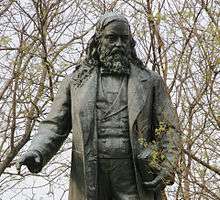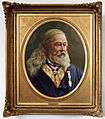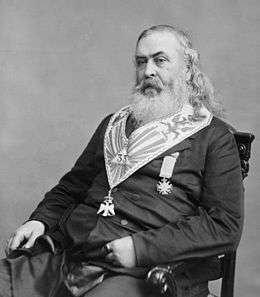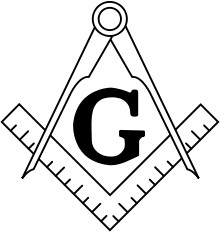Albert Pike
| Albert Pike | |
|---|---|
|
Albert Pike by Mathew Brady | |
| Born |
August 15, 1809 Boston, Massachusetts |
| Died |
April 2, 1891 (aged 81) Washington, D.C. |
| Place of burial | Oak Hill Cemetery |
| Allegiance |
|
| Service/branch |
|
| Years of service |
1846–47 (USA) 1861–62 (CSA) |
| Rank |
|
| Battles/wars |
Mexican–American War American Civil War |
Albert Pike (December 29, 1809 – April 2, 1891) was an attorney, soldier, writer, and Freemason. Albert Pike is the only Confederate military officer with an outdoor statue in Washington, D.C.
Early life
Pike was born in Boston, Massachusetts, the son of Ben and Sarah (Andrews) Pike, and spent his childhood in Byfield and Newburyport, Massachusetts. His colonial ancestors settled the area in 1635,[1] and included John Pike (1613–1688/1689), the founder of Woodbridge, New Jersey.[2] He attended school in Newburyport and Framingham until he was 15. In August 1825, he passed entrance exams at Harvard University, though when the college requested payment of tuition fees for the first two years he chose not to attend. He began a program of self-education, later becoming a schoolteacher in Gloucester, North Bedford, Fairhaven and Newburyport.[3]
Pike was an imposing figure; six feet tall and 300 pounds with hair that reached his shoulders and a long beard.[4][5] In 1831, he left Massachusetts to travel west, first stopping in Nashville, Tennessee and later moving on to St. Louis, Missouri. There he joined an expedition to Taos, New Mexico, hunting and trading.[1] During the excursion his horse broke and ran, forcing Pike to walk the remaining 500 miles to Taos. After this he joined a trapping expedition to the Llano Estacado in New Mexico and Texas. Trapping was minimal and, after traveling about 1,300 miles (650 on foot), he finally arrived at Fort Smith, Arkansas.[5]
Journalist and lawyer

Settling in Arkansas in 1833, Pike taught in a school and wrote a series of articles for the Little Rock Arkansas Advocate under the pen name of "Casca."[6] The articles were popular enough that he was asked to join the newspaper's staff. After marrying Mary Ann Hamilton in 1834, he purchased the newspaper.[7] Under Pike's administration the Advocate promoted the viewpoint of the Whig Party in a politically volatile and divided Arkansas December 1832.[6]
He was the first reporter for the Arkansas Supreme Court and also wrote a book (published anonymously), titled The Arkansas Form Book, which was a guidebook for lawyers. Pike then began to study law and was admitted to the bar in 1837, selling the Advocate the same year. He also made several contacts among the Native American tribes in the area. He specialized in claims on behalf of Native Americans against the federal government.[4] In 1852 he represented Creek Nation before the Supreme Court in a claim regarding ceded tribal land. In 1854 he advocated for the Choctaw and Chickasaw although compensation later awarded to the tribes in 1856 and 1857 was insufficient.[7] These relationships were to influence the course of his Civil War service.
Additionally, Pike wrote on several legal subjects and continued producing poetry, a hobby he had begun in his youth in Massachusetts. His poems were highly regarded in his day, but are now mostly forgotten. Several volumes of his works were privately published posthumously by his daughter. In 1859, he received an honorary Master of Arts degree from Harvard.[8]
Military career

Mexican-American War
When the Mexican–American War started, Pike joined the Regiment of Arkansas Mounted Volunteers (a cavalry regiment) and was commissioned as a troop commander with the rank of captain in June 1846. With his regiment, he fought in the Battle of Buena Vista. Pike was discharged in June 1847. He and his commander, Colonel John Selden Roane, had several differences of opinion. This situation led finally to an "inconclusive" duel between Pike and Roane on July 29, 1847 near Fort Smith, Arkansas.[9] Although several shots were fired in the duel, nobody was injured, and the two were persuaded by their seconds to discontinue it.[10]
After the war, Pike returned to the practice of law, moving to New Orleans for a time beginning in 1853. He wrote another book, Maxims of the Roman Law and some of the Ancient French Law, as Expounded and Applied in Doctrine and Jurisprudence.[11] Although unpublished, this book increased his reputation among his associates in law. He returned to Arkansas in 1857, gaining some amount of prominence in the legal field and becoming an advocate of slavery, although retaining his affiliation with the Whig Party.
In 1847 Pike became disillusioned when the Whig Party refused to take a stand on slavery. At the Southern Commercial Convention of 1854, Pike said the South should remain in the Union and seek equality with the North, but if the South "were forced into an inferior status, she would be better out of the Union than in it."[12] His anti-Catholicism stand led him to join the Know Nothing movement when it was organized in 1856, but was again disappointed when it refused to adopt a strong pro-slavery platform. He joined the other Southern delegates and walked out of the convention. His stand was that state's rights superseded national law and supported the idea of a Southern secession. This stand is made clear in his pamphlet of 1861, "State or Province, Bond or Free?"[6]
Civil War
In 1861 Pike penned the lyrics to Dixie to Arms!.[13] At the beginning of the war, Pike was appointed as Confederate envoy to the Native Americans. In this capacity he negotiated several treaties, one of the most important being with Cherokee chief John Ross, which was concluded in 1861.[4]
Pike was commissioned as a brigadier general on November 22, 1861, and given a command in the Indian Territory. With Gen. Ben McCulloch, Pike trained three Confederate regiments of Indian cavalry, most of whom belonged to the "civilized tribes", whose loyalty to the Confederacy was variable. Although initially victorious at the Battle of Pea Ridge (Elkhorn Tavern) in March 1862,[1] Pike's unit was defeated later in a counterattack, after falling into disarray. When Pike was ordered to send troops to Arkansas in May 1862, he resigned in protest.[7] As in the previous war, Pike came into conflict with his superior officers, at one time drafting a letter to Jefferson Davis complaining about his direct superior.[14]
After Pea Ridge, Pike was faced with charges that his troops had scalped soldiers in the field.[15] Maj. Gen. Thomas C. Hindman also charged Pike with mishandling of money and material, ordering his arrest.[16] Both these charges were later found to be considerably lacking in evidence; nevertheless Pike, facing arrest, escaped into the hills of Arkansas, sending his resignation from the Confederate Army on July 12.[16] He was at length arrested on November 3 under charges of insubordination and treason, and held briefly in Warren, Texas, but his resignation was accepted on November 11 and he was allowed to return to Arkansas.[16]
Freemasonry
Pike first joined the Independent Order of Odd Fellows in 1840, and he had then joined a Masonic Lodge, where he became extremely active in the affairs of the organization, being elected Sovereign Grand Commander of the Scottish Rite's Southern Jurisdiction in 1859.[9] He remained Sovereign Grand Commander for the remainder of his life (a total of thirty-two years), devoting a large amount of his time to developing the rituals of the order.[17] Notably, he published a book called Morals and Dogma of the Ancient and Accepted Scottish Rite of Freemasonry in 1871, of which there were several subsequent editions. Pike stated that half of the text was copied from other works, but did not indicate his sources.[18]
Pike is still regarded in America as an eminent[19] and influential[20] Freemason, primarily in the Scottish Rite Southern Jurisdiction.[21]
Death and legacy
Pike died in Washington, D.C., at the age of 81, and was buried at Oak Hill Cemetery. Burial was against his wishes; he had left instructions for his body to be cremated.[22] In 1944, his remains were moved to the House of the Temple, headquarters of the Southern Jurisdiction of the Scottish Rite. A memorial to Pike is located in the Judiciary Square neighborhood of Washington, D.C.
The Albert Pike Memorial Temple is a historic Masonic lodge in Little Rock, Arkansas listed on the National Register of Historic Places.[23]
-

Morals and Dogma (1871)
-

Pike in Masonic regalia
Poetry
As a young man, Pike wrote poetry and he continued to do so for the rest of his life. At 23, he published his first poem, “Hymns to the Gods.” Later work was printed in literary journals like Blackwood’s Edinburgh Magazine and local newspapers. His first collection of poetry, Prose Sketches and Poems Written in the Western Country, appeared in 1834.[5] He later gathered many of his poems and republished them in Hymns to the Gods and Other Poems (1872). After his death these appeared again in Gen. Albert Pike’s Poems (1900) and Lyrics and Love Songs (1916).[6]
Selected works
- Indo-Aryan Deities and Worship as Contained in the Rig-Veda (1872)
- Morals and Dogma of the Ancient and Accepted Scottish Rite (1872)
- Book of the Words (1874)
- Reprints of Old Rituals (1879)
See also
- List of American Civil War generals (Confederate)
- List of Freemasons
- Treaty with Choctaws and Chickasaws
References
- 1 2 3 "Massachusetts born CSA general Albert Pike leads brigade of Native Americans at the Battle of Pea Ridge", Massachusetts Sesquicentennial Commission of the American Civil War
- ↑ Albert's descent from his immigrant ancestor John Pike is as follows: John Pike (1572–1654); John Pike (1613–1688/89); Joseph Pike (1638–1694); Thomas Pike (1682–1753/4); John Pike (1710–1755); Thomas Pike (1739–1836); Benjamin Pike (1780–?); Albert Pike (1809–1891).
- ↑ Hubbell, Jay B. (1954) The South in American Literature: 1607–1900. Durham, North Carolina: Duke University Press. p. 640.
- 1 2 3 "Albert Pike - Hero or Scoundrel?", The Smithsonian Associates Civil War E-Mail Newsletter, Volume 5, Number 1, Civil War Studies.org, Smithsonian Associates
- 1 2 3 Cutrer, Thomas W., "Pike, Albert", The Handbook of Texas, Texas State Historical Association
- 1 2 3 4 Moneyhon, Carl H. (February 4, 2009), Albert Pike (1809–1891), Encyclopedia of Arkansas History & Culture, retrieved November 14, 2009
- 1 2 3 Westmoreland, Ingrid P., "Pike, Albert", Oklahoma Historical Society
- ↑ "The Phoenix," Manly P. Hall
- 1 2 Eicher, John H., aer (2001) Civil War High Commands. Stanford: Stanford University Press. ISBN 0-8047-3641-3. p. 429
- ↑ Allsopp, Frederick William. A Life of Albert Pike, Parke-Harper news service, 1920
- ↑ Brown, Walter Lee (1997). A life of Albert Pike. Fayetteville: University of Arkansas Press. pp. 61, 240, 302, 408. ISBN 1557284695.
- ↑ Potter, David Morris and Edward, Don (1976) The impending crisis, 1848–1861. HarperCollins. p. 467
- ↑ "Dixie to Arms!", Roy Rosenzweig Center for History and New Media, George Mason University
- ↑ Boyden, William Llewellyn (1921). Bibliography of the Writings of Albert Pike: Prose, Poetry, Manuscript. Washington, D.C.: A.A.S.C. p. 18.
- ↑ Shea, William, and Earl Hess, Pea Ridge: Civil War Campaign in the West. University of North Carolina Press, 1992. ISBN 0-8078-4669-4.
- 1 2 3 Smith, Dean E. (1986) "Pike, Albert" in Historical Times Illustrated History of the Civil War, edited by Patricia L. Faust. New York: Harper & Row. ISBN 978-0-06-273116-6. p. 585
- ↑ Warner, Ezra J. (1959) Generals in Gray: Lives of the Confederate Commanders. Baton Rouge: Louisiana State University Press. ISBN 0-8071-0823-5. pp. 240–241
- ↑ Morals and Dogma at "Sacred Texts"
- ↑ ALBERT PIKE AND FREEMASONRY. California Freemason
- ↑ Albert Pike, masonicinfo.com
- ↑ Albert Pike Museum, The Scottish Rite of Freeemasonry
- ↑ PIKE, Brigadier General Albert: Memorial at the Municipal Center in Washington, D.C.. dcmemorials.com
- ↑ "Historic Albert Pike Masonic Center", Little Rock Convention and Visitors Bureau
Bibliography
- Abel, Annie (2007). The American Indian as Participant in the Civil War. City: BiblioBazaar. ISBN 1-4264-6170-4.
- Allsopp, Fred (1997). Albert Pike a Biography. City: Kessinger Publishing. ISBN 1-56459-134-4.
- Brown, Walter (1997). A Life of Albert Pike. Fayetteville: University of Arkansas Press. ISBN 1-55728-469-5.
- Cousin, John (2003). Short Biographical Dictionary of English Literature. City: Kessinger Publishing, LLC. ISBN 0-7661-4348-1.
- Morris, S. Brent (2006). The Complete Idiot's Guide to Freemasonry. Alpha Books. ISBN 1-59257-490-4.
-
 This article incorporates text from a publication now in the public domain: Cousin, John William (1910). A Short Biographical Dictionary of English Literature. London: J. M. Dent & Sons. Wikisource
This article incorporates text from a publication now in the public domain: Cousin, John William (1910). A Short Biographical Dictionary of English Literature. London: J. M. Dent & Sons. Wikisource
External links
| Wikimedia Commons has media related to Albert Pike. |
| Wikisource has original works written by or about: Albert Pike |
My Personal Views On Pike's Morals and Dogma masonicme.com
| Wikiquote has quotations related to: Albert Pike |
- Works by Albert Pike at Project Gutenberg
- Works by or about Albert Pike at Internet Archive
- Pike's Masonic philosophy
- About Pike's famous Luciferian quote
- About room where he is entombed at the Wayback Machine (archived February 23, 2006)
- Albert Pike commemorative Masonic Lodge – Located in Denver CO
- Lafferty, R.A. (1991). Okla Hannali. Oklahoma: University of Oklahoma Press. ISBN 0-8061-2349-4.
- Pike's words for Dixie ("Everybody's Dixie", also known as "To Arms in Dixie")
- Albert Pike at Find a Grave

